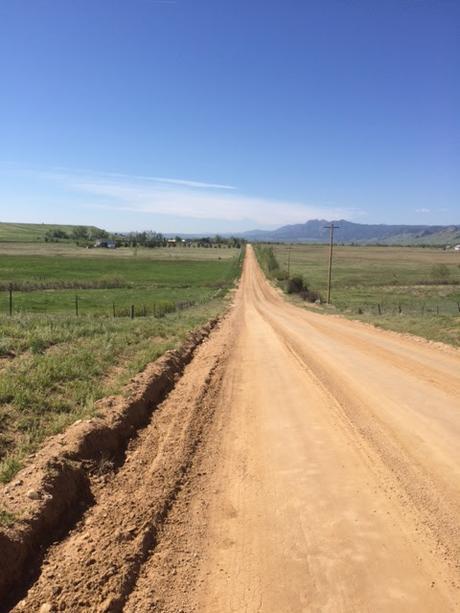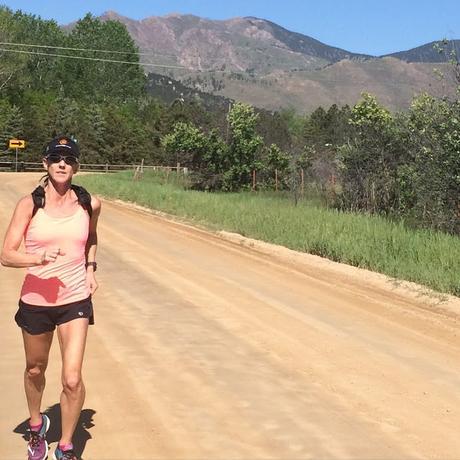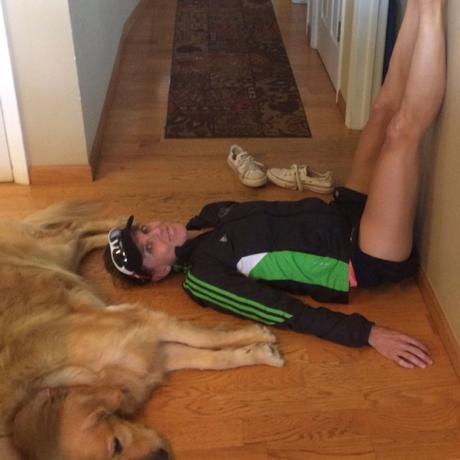Last week. A fantastic training week as the miles start to pile on.
Tuesday: 5.2 easy miles in the rain.
Wednesday: Swim 1 mile.
Thursday: 7 tough miles on the trail (climb 1,800 feet)
Friday: 6.1 miles with 10 short hill sprints thrown in (pooped under a bridge!) Climb 700 feet
Saturday: Off (well, 1 mile with Heidi because she can only run that far)
Sunday 15 miles easy, but 15 miles never feels easy Climb 1,200 feet
Total: 34.3 miles of running, 1 mile of swimming. Climbing = ~3,700 feet
Scenes from it all:

A most spectacular day for running in Boulder

Happy runner:
Just had a cherry chocolate gel. Only 6 miles to go. Don't even have to poop.

Doing my favorite post-long run stretch. "Leg Drain" - blood drains down so when you stand up,
new blood circulates in. Or you pass out.
In my opinion, there is one aspect of training that is often overlooked.
Sure we all know about recovery days, preventing injury, nutrition, etc. But, what about race specific training? When you are training for a race, how accurately and thoroughly do you study the course (even if you are far away, these days there are pretty decent course maps online)? Running 13.1 or 26.2 miles can vary tremendously based on certain things. Take the following 5 things into account when training for your next race and make adaptations/changes to your plan as necessary.
- The surface: Will you be running on pavement, concrete, road or trail? This matters because you need to train your body for that surface.
- The elevation gain/loss: What are the hills like on your course? When people think "hills" they think mostly about running UP. But training to run DOWN is equally as important. Not only is there actually a way to run down (see HERE), but you need to train your legs (quads) for the descents.
- The weather: It's easy enough to get the average temperature for the time when you will be racing. Also look at things like humidity or lack thereof. If you aren't used to dry air, there could be some adverse affects on you as you run (see HERE). On the other hand, if you live in a dry climate and aren't used to humidity, be prepared to potentially see a dip in your performance. The risk of overheating is higher during humid workouts because the body is working harder to cool off in the saturated air.
- The altitude: This is a no brainer. If you are training near sea level and are traveling for a higher altitude race, you need to prepare yourself. Less oxygen in the air means breathing can be tough as hell. Read this closely: If you are going to a race at a higher altitude, the best bet is to get there 7 to 10 days in advance to let your body adapt. However, if you can't do that, your next best option (even though this sounds counter intuitive) is to arrive as close to race day as possible, preferably within 18 to 48 hours. This is because the body has the toughest time acclimating to altitude 2 days to 7 days after arriving at a higher elevation.
- The numbers: Know about how many people will be running the race. Will you be among a crowd of 50,000 or with only 100 people? Will you be held back in the beginning due to crowd congestion? Will you find yourself alone a lot on the trail? These are all good things to know.
Bottom line, race specific training is essential. Not just for performance, but for confidence.
And just for fun:

Heidi and I like to make out. We just got to first base.
What's your best training tip?
SUAR

